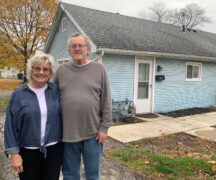By JAN LARSON McLAUGHLIN
BG Independent News
Bowling Green’s Historic Preservation Commission wants people to explore history in the downtown, in their neighborhoods, and in places where it no longer exists.
On Tuesday, the commission again discussed the stories that still reverberate in the downtown, the historically significant buildings that still stand throughout the community, and the sites that have been demolished but the stories that still linger.
To achieve those goals, the commission is working on writing interpretive signs for the downtown area. Bowling Green Planning Commission Director Heather Sayler said the city is seeking funding to design 12 single-sided pedestal signs to point out the notable historical significance of the downtown.
Sayler suggested that two signs be erected on both sides of every downtown block – including North Main, South Main, East Wooster and West Wooster streets.
“I think it’s a really important part of the community for historic preservation,” Sayler said Tuesday during a meeting of the city’s Historic Preservation Commission.
The commission also continued discussion about yard signs stating “History Lives Here” to be placed in front yards of historic structures throughout the city. Members of the public are invited to submit their homes or businesses for the designation.
And the commission again talked about convincing neighborhoods or street blocks about the value of designating their areas as local historical preservation districts. The first attempt to designate a block involves North Maple Street between West Wooster and Wallace streets, and possibly to Conneaut Avenue.
“There’s a lot of neighborhood spirit there,” said commission member Geoff Howes. John Sampen mentioned that he lives in the historic block.

The commission has repeatedly stressed that owners of historic properties will not be told what to do with their homes or businesses.
Rather than creating long lists of specific recommendations, the commission agreed to use guidelines recommended by the Secretary of Interior for the treatment of historic properties.
The proposal for the historic preservation commission was first brought up in 2009, then became part of earnest discussions in 2013. Efforts died in 2015 after some citizens interpreted the city’s preservation efforts as government telling them what to do with their properties.
At that time, Mayor Dick Edwards tried to explain that the commission was there to help – not give orders.
Nevertheless, suspicions and very vocal objections by a few citizens about the motivation for the historic preservation commission killed the effort.
This time around, the city and the commission members are working to do a better job of educating the public and calming fears.
The goal of historic preservation is to protect the historic integrity of buildings – and help when possible with restorations. It is not to nitpick and tell homeowners what they can and cannot do with their properties.
Three sites and two historic districts in Bowling Green are currently listed on the National Register of Historic Places by the Secretary of the Interior upon recommendation of the Ohio Historic Preservation Office. However, placement on the National Register provides no protection to any historic property.
To fully function, the city became a Certified Local Government through the Ohio Historic Preservation Office. The CLG status allows the city to get preservation grants and tax credits to help homeowners and businesses protect historic buildings.





